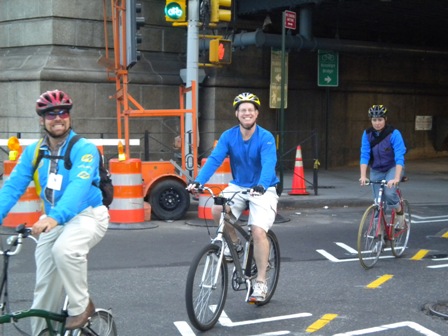
There’s an adage that says cars run on gas and make you fat, bikes run on fat and save you money, but this year’s Association of Pedestrian and Bicycle Professionals convention will be focused on how communities can find ways to invest in infrastructure to support bikers and walkers in a time when government legislation could steer all of that cash to cars.
The Association of Pedestrian and Bicycle Professionals will hold a professional development seminar in Boulder Sept. 9-12. The series of classes, speakers and mobile tools, based on this year’s theme of “Dollars and Sense: Economics, Health and Social Benefits of Walking and Bicycling,” will feature transportation and planning professionals from across North America. The program is set to explore ideas about creative funding sources for biking and pedestrian infrastructure in a political climate that recently saw slashed guaranteed funds for alternative transportation projects.
The seminar comes one year after Congress passed MAP 21, a transportation bill that allows the Department of Transportation and municipal planning organizations to transfer 50 percent of their alternative transportation project funds to general highway improvement programs. The legislation effectively slashes guaranteed funding for biking and walking programs, according to Advocacy Advance, a partnership between Alliance for Biking & Walking and the League of American Bicyclists created to boost state and local biking and pedestrian advocacy and see that those projects still receive financial support as states determine their transportation projects. Legacy programs from the previous transportation bill like Safe Routes To School, Transportation Enhancements and Recreational Trails still qualify for money, but could potentially lose funding to conventional road projects.
Colorado has committed to not transferring money away from its alternative programs, according to a report released in early August by Advocacy Advance. But the need to convey the economic and social benefits of biking and pedestrian programs will become more important as other states figure out how to allocate funds.
As local governments work to sort out what to do with their allotted funds from that transportation bill, the Association of Pedestrian and Bicycle Professionals has moved its semi-annual convention to Boulder to show people what can be done with a little investment and political will behind promoting pedestrian and bike transportation.
“Boulder is a living laboratory for walkable, bicycle-friendly communities,” says Kit Keller, executive director of the Association of Pedestrian and Bicycle Professionals. “We’re excited to showcase Boulder because so many cities in the U.S. are where Boulder was 20 years ago — they can learn a lot from Boulder.”
Boulder residents walk, bike and ride public transportation at a higher rate than the national average, according to the association.
Moving into their eighth seminar in 16 years, the three-day conference will present the opportunity to attend classes and mobile tours in Boulder, Denver and Fort Collins that will highlight some of the successful bicycle and pedestrian programs, like Boulder’s Valmont Bike Park and Community Cycles.
“Political will often drives funding and the availability of funding — where there’s a will there’s a way,” says Keller. “Part of why we’re coming to Boulder is to show the economic development benefits of making the decision to be a more walkable, bicycle-friendly community and the advantages of working across disciplines.”
Despite more complicated and less secure funding for alternative transportation, Sean Co, a speaker at the seminar and lead planner for bicycle and pedestrian transportation planning and funding at the Metropolitan Transportation Commission in the San Francisco Bay Area, says there are still a lot of opportunities to secure funding.
“Depending where you are, some elected officials really get it, and some need quite a bit of explanation,” Co says. “I think from an advocate’s point of view, it’s important to find out what the elected officials are interested in and then you can tailor your message to their interests. Whether it’s about congestion relief or the economy, you just have to find what works.”
Co will speak at the convention about what states can do with funds from the Congestion Mitigation and Air Quality Improvement Program, a MAP 21 program continued from the Safe, Accountable, Flexible, Efficient, Equality Act. Conventionally, funds from the congestion mitigation and air quality program are used for highway improvements to address traffic flow like HOV lanes and added turning lanes, which maintain current systems, Co says, but those funds also fit well into biking and pedestrian programs.
Additional information on the seminar can be found at www.apbppds.org.
The seminar´s closing luncheon at 11:45 a.m. on Thursday at the Millennium Harvest House is open to the public. Barbara McCann, founding executive director at the National Complete Streets Coalition, will speak about her forthcoming book, Completing Our Streets: The Transition to Safe and Inclusive Transportation Networks. Tickets can be purchased online for $35 at www.apbp.org.
Respond: [email protected]














